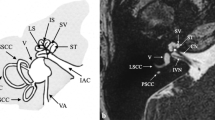Abstract
Hearing plays an important role for children in learning speech and language, socialization and cognitive development. The child learns to speak based on what is heard (Rundjan et al. in Sari Pediatr 6(4):149–154, 2005). The aim of the study was to find out the percentage of hearing loss by OAE among low risk and high risk neonates. All the neonates (Low and High risk) born in a tertiary care center were screened by OAE before their discharge from the hospital and after stabilizing high risk neonates. The referred neonates were followed after two weeks. Total 722 neonates were screened of which 130 were high risk and 592 were low risk. Neonates with Serum bilirubin > 20 mg/dl or requiring exchange transfusion were excluded as OAE will be unreliable in them and they should be subjected to BERA directly. Percentage of bilateral hearing loss came to be 4.2%, 4 participants were lost to follow up and percentage of hearing loss on subsequent OAE came to be 11.6%. Low birth weight was an important risk factor for hearing loss (p value significant on initial and follow-up). Percentage of hearing loss with low birth weight, hyperbilirubenemia, low apgar score and prematurity to be 16%. Mechanical ventilation contributed 13% of total hearing loss followed by ototoxicity. Neonates with family history of childhood SNHL, in utero infection, craniofacial anomaly and bacterial meningitis contributed 3% of total hearing loss. On subsequent follow-up, one neonate was low-risk and the other 25 were high risk, of which 3 high risks showed sustained OAE refer. However the low risk neonate had normal outer hair cell function i.e. OAE pass. This study clearly demonstrates importance of Universal Neonatal Hearing Screening Programme so that hearing loss can be detected as early as possible and possible intervention can be taken at the earliest.

Similar content being viewed by others
References
Rundjan L, Amir I, Suwento R, Mangunatmadja I (2005) Neonatal hearing screening high risk. Sari Pediatr. 6(4):149–154
Jakubíková J (2006) Detskáaudiológia: 0–4 roky. Slovak Academic Press, Bratislava
[Internet]. 2017 [cited 28 September 2017]. Available from: http://www.tribune.cz/clanek/13748-screening-sluchu–amp-soucasne-moznosti-vysetrovan. World Health Organization. Newborn and infant
Strasnick B, Jacobson D (1995) Teratogenic hearing loss. J Am Acad Audiol 6(1):28–38
Baradaranfar MH, Atighechi S, Dadgarnia MH, Jafari R, Karimi G, Mollasadeghi A, Eslami Z, Baradarnfar A (2011) Hearing status in neonatal hyperbilirubinemia by auditory brain stem evoked response and transient evoked otoacoustic emission. Acta Med Iran. 49(2):109–112
Khaimook W, Chayarpham S, Dissaneevate S (2008) The high-risk neonatal hearing screening program in Songklanagarind Hospital. J. Med. Assoc. Thail. 91(7):1038
Gouri, Z., Sharma, D., Berwal, P., Pandita, A., Pawar, S.: Hearing impairment and risk factors by newborn screening in north-western India. Matern. Health, Neonatol. Perinatol. 1(1) (2015)
Kumar, P., Adhisivam, B., Bhat, V.*, Bharathi, B, Francis, F., Mondal, N.: Screening for hearing loss among high risk neonates? Experience from a Tertiary Care Center. Department of Neonatology, JIPMER, Pondicherry 605 006, India
Augustine A, Jana A, Kuruvilla K, Danda S, Lepcha A, Ebenezer J et al (2013) Neonatal hearing screening: experience from a tertiary care hospital in Southern India. Indian Pediatr 51(3):179–183
Fakhim SA, Naderpoor M (2010) Study of prevalence of hearing loss in high risk neonates admitted to neonatal ward. J. Int. Adv. Otol. 6(3):365–370
Uchôa NT, Procianoy RS, Lavinsky L, Sleifer P (2003) Prevalence of hearing loss in very low birth weight neonates. J Pediatr. (Rio J) 79(2):123–128
John M, Balraj A, Kurien M (2009) Neonatal screening for hearing loss: pilot study from a tertiary care centre. Indian J. Otolaryngol. Head Neck Surg. 61(1):23–26
Funding
This study was not funded by anyone.
Author information
Authors and Affiliations
Corresponding author
Ethics declarations
Conflict of interest
All authors declare that they have no conflict of interest.
Ethical Approval
All procedures performed in studies involving human participants were in accordance with the ethical standards of the institutional and/or national research committee and with the 1964 Helsinki declaration and its later amendments or comparable ethical standards.
Informed Consent
Informed consent was obtained from all individual participants included in the study.
Rights and permissions
About this article
Cite this article
Jadia, S., Qureshi, S., Raghuwanshi, P. et al. Role of Otoacoustic Emissions in Hearing Assessment of Neonates: A Prospective Observational Study. Indian J Otolaryngol Head Neck Surg 71 (Suppl 2), 1187–1189 (2019). https://doi.org/10.1007/s12070-018-1256-0
Received:
Accepted:
Published:
Issue Date:
DOI: https://doi.org/10.1007/s12070-018-1256-0




